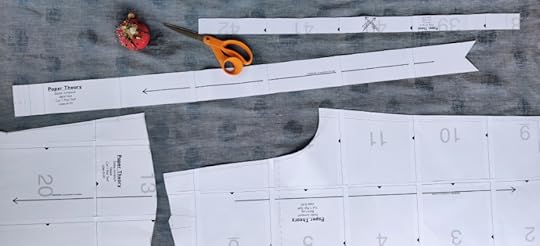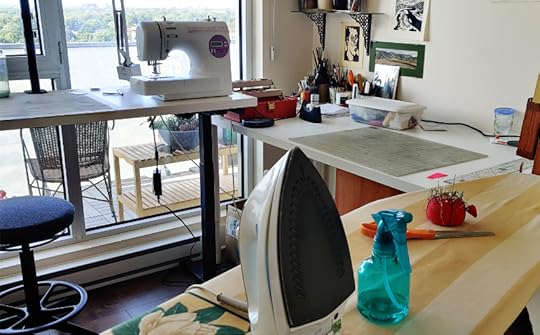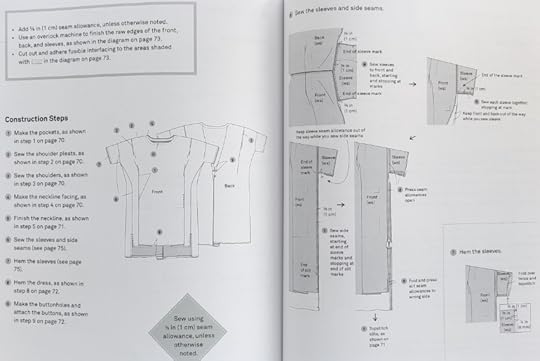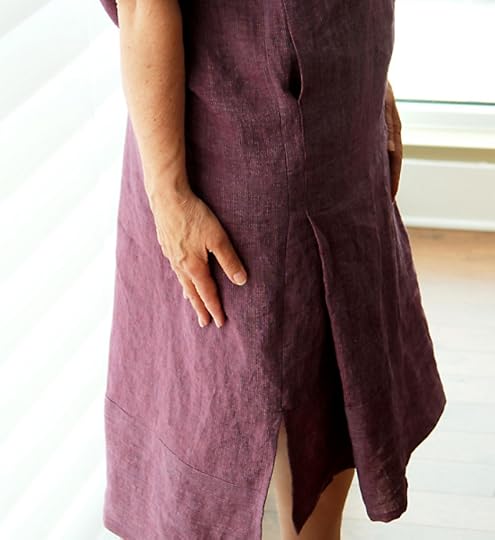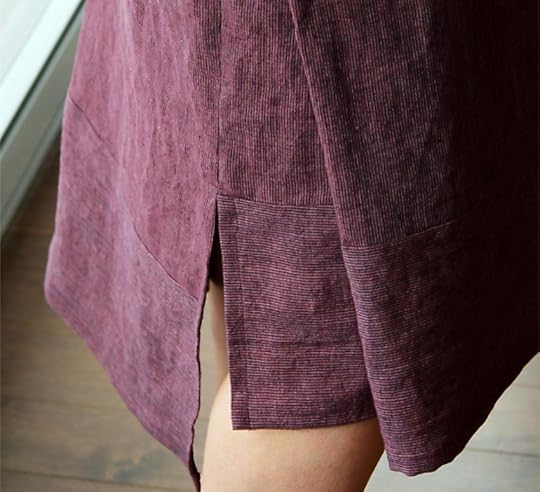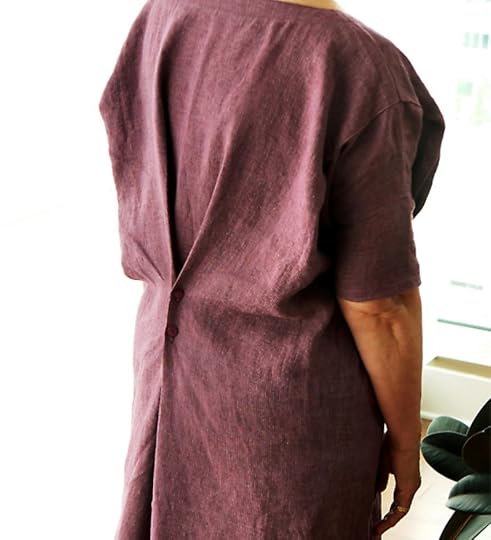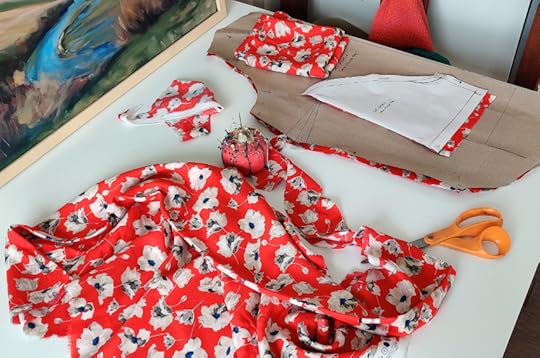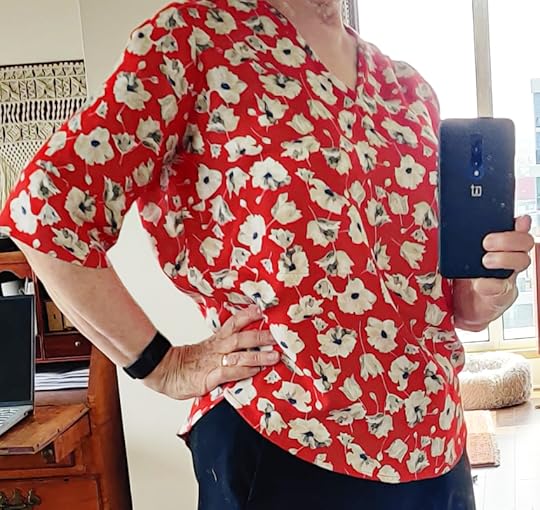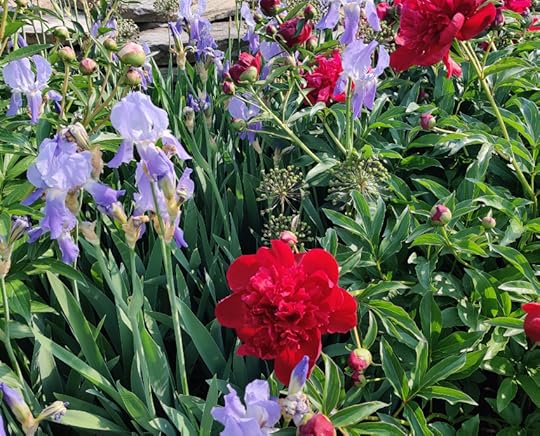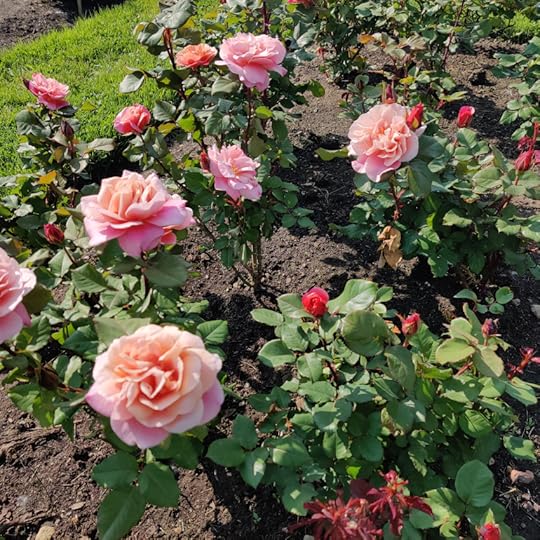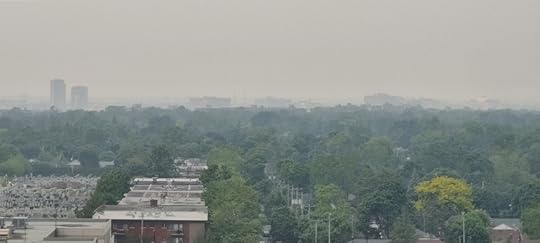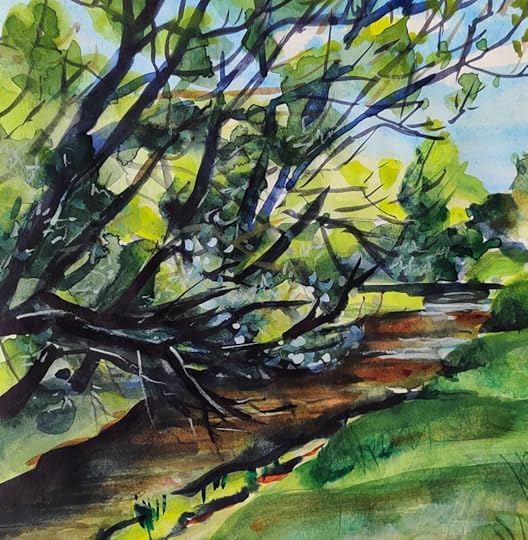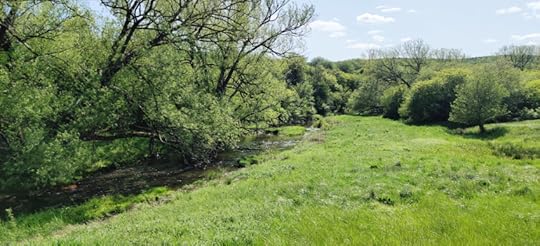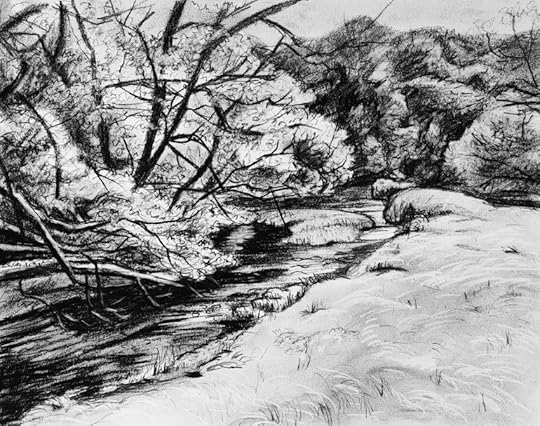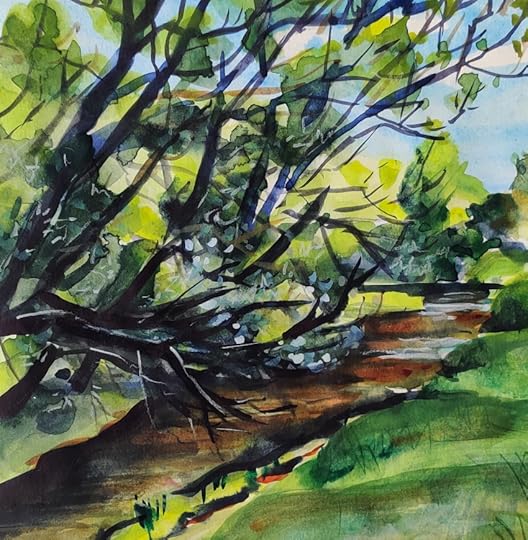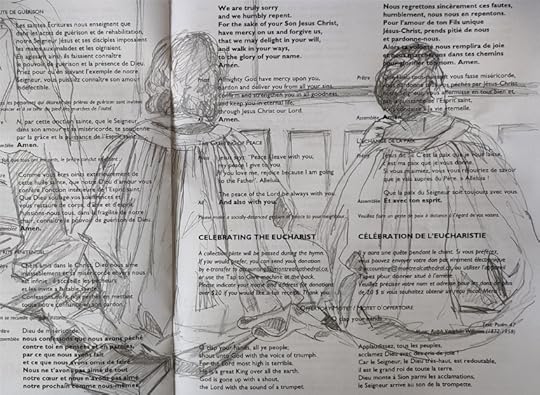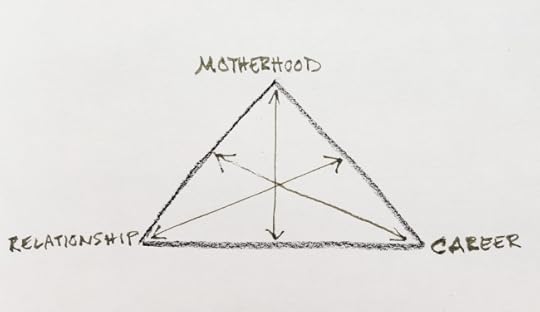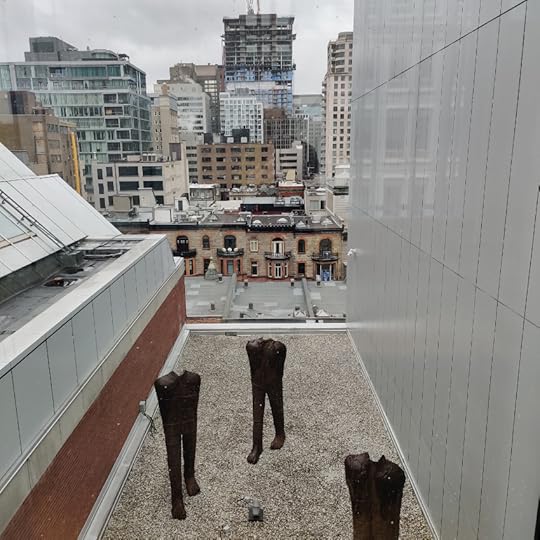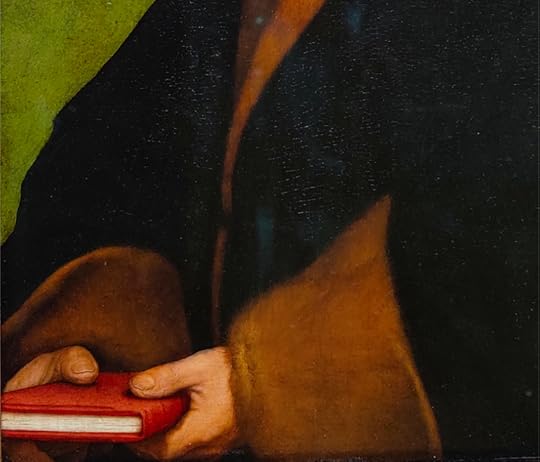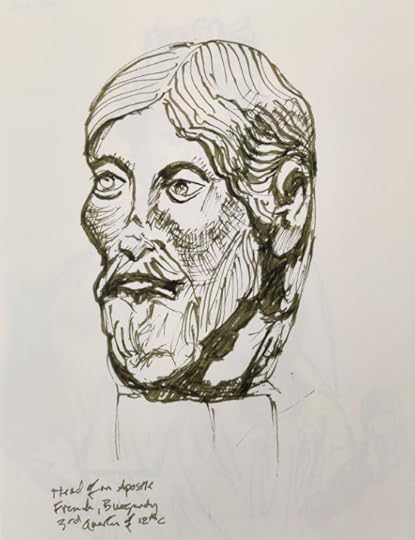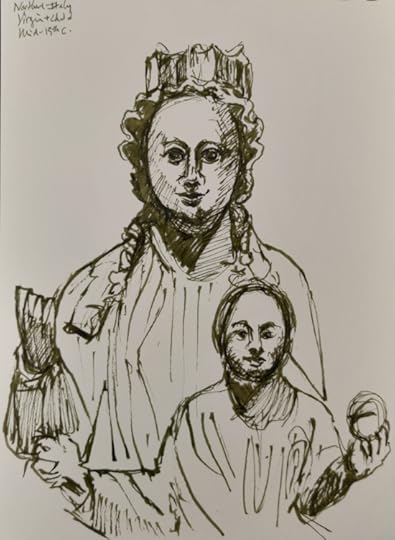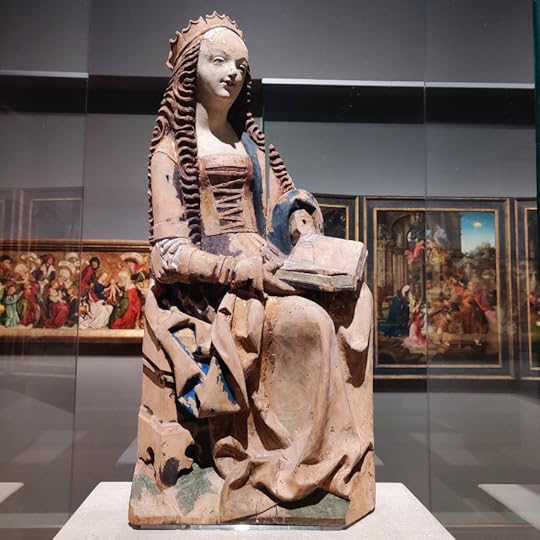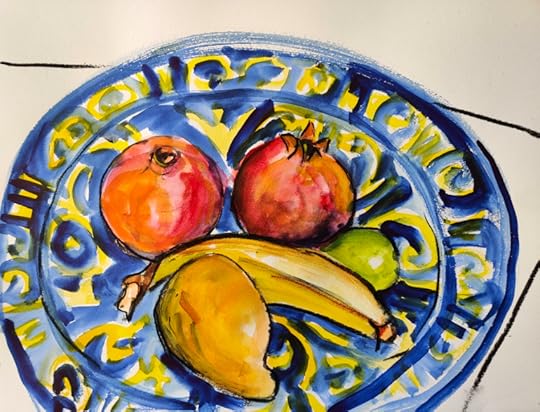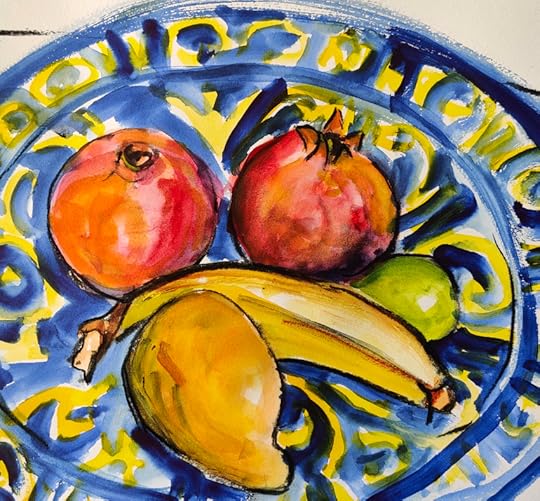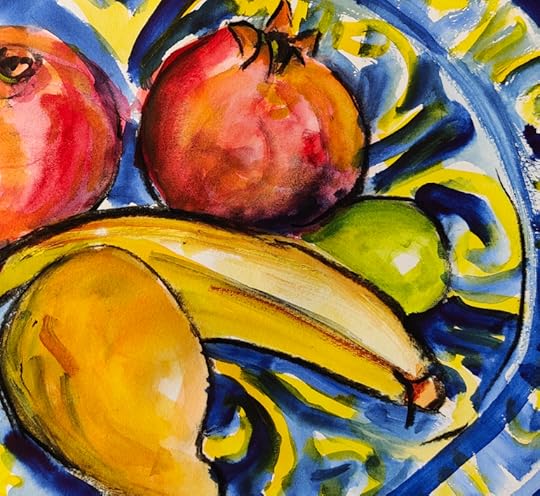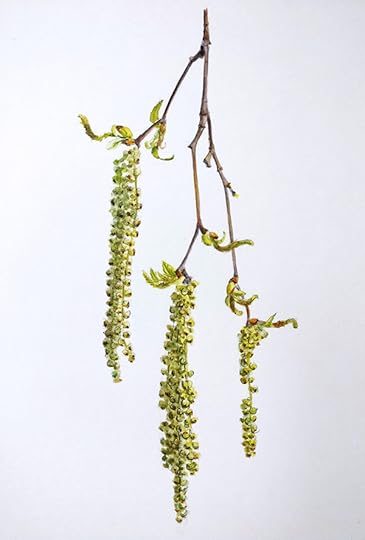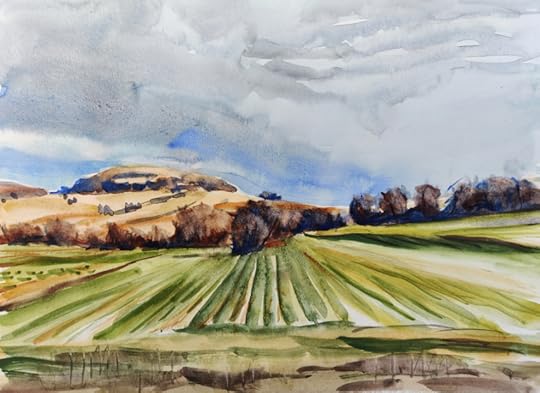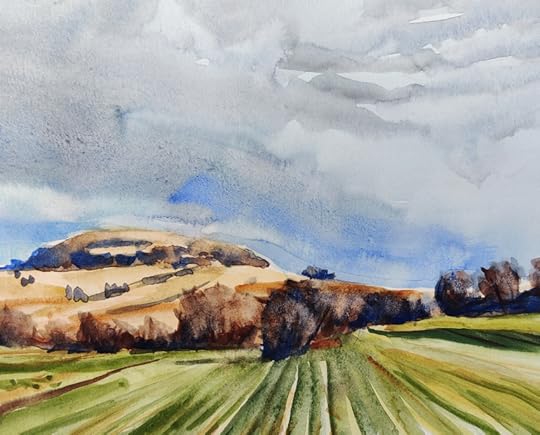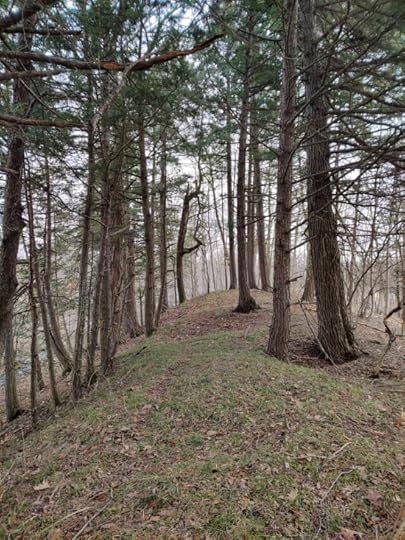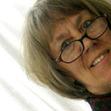Elizabeth Adams's Blog, page 9
July 24, 2023
A Report on my Summer Sewing Binge - Part 1
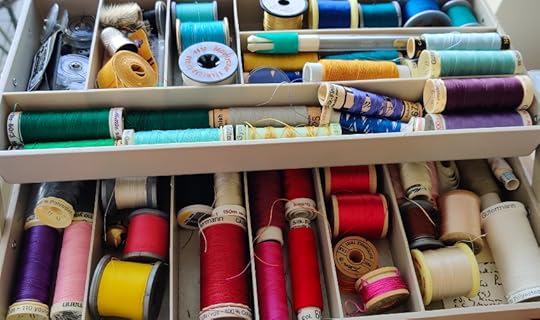
I've always kept my threads and sewing tools in a tackle box. Don't laugh -- there are precious things in it. For instance, in the top drawer you can see my great-grandmother's silver thimble, and a sealskin thimble brought to me by my niece from Sitka, Alaska, where she did a writer's residency. In the lower drawer are several spools of silk thread that were my mother-in-law's, and a package of hand-sewing needles bought in Mexico City. If I look closely, I think I also see a bell that was on our first cat's collar.
The sewing I've been doing this summer started as an experiment. As in my food choices, I've wanted to become more conscious of where our clothing comes from, who our dollars support or hurt, its environmental impact, and how the industry operates. I am neither a purist nor a crusader: I've bought plenty of clothes at Zara, H&M, Gap, Old Navy, and many other clothing companies that use offshore manufacturing. But like my friend K., who writes the blog Passage des Perles, I do shop at thrift stores, and am becoming more and more unwilling to support the fast-fashion industry, distressed by its reduced fabric quality and construction, and underwhelmed by the styles as well as their positioning to a much younger consumer. I also didn't want to spend $200-$300 on just one or two items at local boutiques run by Quebec designers. For that amount of money, I wondered what I could actually make myself, and whether or not I'd be happy with the result. I've enjoyed sewing clothes my entire life, but haven't done much in the past ten or fifteen years ago, partly because of the decline of local fabric stores selling high-quality fabrics for apparel. (Montreal still has several quilting, upholstery, and costume-fabric stores.) What I've learned over the past month of research and sewing has been enlightening, so I wanted to share it. I'll divide the following list into two parts, spread over two blog posts, and try to make it interesting for the non-sewers as well.
Motivation
Inspiration
Planning
Acquiring patterns and materials
Construction
Economics - total cost, and comparison to ready-made
Quality
Satisfaction
Future Plans
OK! Let's get started!
Motivation
When we moved to this apartment a year ago, I got rid of everything in my closet that I wasn't wearing regularly. If the items were still in good shape, I donated them to local thrift shops, and the rest I recycled or threw out, except for a few beautiful handknit sweaters that I gave to friends. I had been holding onto garments that were twenty and thirty years old, so this was a real purge, long overdue. The biggest hole it created was for summer clothes: when spring came this year, I realized I didn't have much besides jeans and tee shirts, a few tops, one pair of linen pants, and a few special-occasion dresses and long skirts.
So, I did some shopping...and I wasn't happy with what I found. Not only did the clothes seem expensive, but even in higher-end fast-fashion stores like Zara and Mango, I was disappointed in the uneven quality of the fabrics, the lack of natural fibers, and the cheap construction. Uniqlo was better, but I wasn't really in the market for basics. I buy my jeans at Old Navy, but most of their other clothes tend to be cheap imports in synthetic fabrics. I was looking for linen, or linen-cotton blends. I also checked thrift and vintage stores, where I've found a number of treasures in the past, but didn't find anything this time around.
Inspiration
Since I follow a lot of sewing and knitting sites on Instagram, and had been searching online, of course I began to get ads for linen clothing and fabrics. After reading a lot of reviews in early spring, I did order a pure linen asymmetrical skirt and a matching top from a direct-to-consumer fashion company called Grae Cove that sells simply-designed linen dresses, skirts, tops and pants. The headquarters are in California and Hong Kong, the factories are Chinese, and -- for what it's worth -- the company has both a sustainability statement and clearly stated policies about ethical workplace conditions and compensation, though I had no way to really check. (It is true that linen and wool both have lower environmental impact than cotton or synthetics.) Anyway, the items I ordered arrived quickly and were well made, at a good price, in high-quality fabric in a beautiful color. The skirt fit perfectly and I've worn it all summer. But the top, for which I had used their size guide, was way too large and boxy. I didn't want to return it, and figured eventually I'd cut it apart or see if I could alter it to fit. But the main message I got from that order was that I should try making simple clothes like these myself, spending my own time doing something that - for me anyway - is fun and constructive. Since I hadn't sewn in a while, I was a little unsure how it would go, but when I found excellent quality linen online, I got inspired, and took the plunge. I also did a lot of pattern-shopping online among independent designers and small companies that I'm happy to support, as well as acquiring the two Japanese sewing books I mentioned in an earlier post.
Planning and Acquisition
The linen, linen blends, and rayon fabrics I ordered were with specific projects and patterns in mind, and I had a few pieces in my stash as well. I wanted to make one or two dresses, a jumpsuit, a couple of new tops, and at least one pair of pants. First, I studied the pattern specifications carefully, since patterns almost always suggest the most suitable types and weights of fabric, and tried to match my fabric choices with those. Buying fabric online is tricky because you can't feel it, or hold a length in your hand to test the drape, or hold it up to the light to see how opaque or transparent it is -- and all of these things are important. It's even hard to judge the scale of printed or woven designs, which is why online stores often include a ruler in one of the photos of the fabrics they're offering. I'm an experienced sewer, but it still makes me nervous to buy fabric this way: cut lengths of fabric are not returnable! Fortunately, my choices worked out pretty well.
I also live within a five-minute walk from the local Fabricville (a Canadian equivalent for JoAnn Fabrics in the US), where I rarely find fabric I love, but can get every conceivable notion from elastic and interfacing to extra sewing machine bobbins.
There was a learning curve for a Brother sewing machine I was given by K.; I wanted to use it for these projects but only after sewing test swatches and becoming quite familiar with it. There were definitely things to learn, both by reading the manual and by trial and error, so that took a fair amount of time. Sewing has also evolved in recent years: I'm still finding out about the newest fabric markers, next-generation fusible interfacings and seam stabilizers, as well as getting used to printing out .pdf patterns bought online or tracing the ones in the backs of sewing books, adding seam allowances, making alterations, and setting up a system for storing them.
Construction
Then it was time to cut! I'm in a new space, without the big tables of my former studio, but to my surprise it's turned out that this small workroom is the most efficient sewing space I've ever had. The table for the sewing machine and the work table form an L, and across from the machine I have the ironing board, so everything is within a few steps. I did most of the cutting on the floor, which reminded me of being in high school, when Mom and I always cut our patterns on the carpeted dining room floor. The difference is that my body is many decades older, and this was a bit hard on my back and knees after a while -- but I figured it was good for me ;-)
The actual sewing went pretty well. I had self-drafted a top in two hemline variations copied from an existing favorite, originally from H&M. For the rest of the projects, I had chosen pretty simple patterns without fussy tailoring details. The only difficulties were in the somewhat minimal Japanese instructions, which definitely required some prior knowledge of sewing, and figuring out their unfamiliar fitting methods of folding and draping fabric, but I was both intrigued and impressed with the clarity of the pictures and instructions for all of these patterns. For Paper Theory's "Zadie" jumpsuit and "Block Tee" I also found numerous helpful notes online that other sewers had written as they made their garments, along with YouTube instructions that helped with things like making neat bias bindings for the v-necks of my self-drafted tops. The internet is a godsend for do-it-yourselfers, and I was grateful for the help there, which has now replaced the voluminous instructions on the Vogue patterns I grew up with, and my late grandmother's expertise when I would get stuck.
In the next post, I'll assess what I ended up with after this sewing blitz: the quantity and quality of the garments, and whether or not it was worth it to spend my money and time in this way.
July 3, 2023
Sewing a Japanese Dress
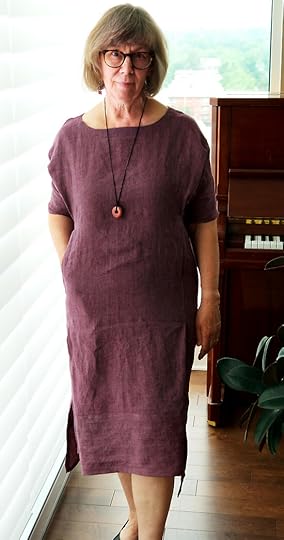 Life has felt kind of fragmented lately, between Montreal and central New York, and it's been hard to sustain the necessary concentration for writing and artwork -- but I've felt like I needed a break anyway. Sewing and cooking have both felt like good things to do. For the past three days, I've been working on a new project from the "Nani Iro Sewing Studio" book. Nani Iro is a Japanese clothing and textile designer, and in this book she presents 18 patterns for tops, dresses, pants and coats. All have simple shapes, but in some cases the construction is both clever and tricky. That was the case with the first project I chose, the "Elbow Sleeve Pocket Dress" shown here. I got completely fascinated with it from the minute I unfolded the pattern sheets from their envelope in the back of the book.
Life has felt kind of fragmented lately, between Montreal and central New York, and it's been hard to sustain the necessary concentration for writing and artwork -- but I've felt like I needed a break anyway. Sewing and cooking have both felt like good things to do. For the past three days, I've been working on a new project from the "Nani Iro Sewing Studio" book. Nani Iro is a Japanese clothing and textile designer, and in this book she presents 18 patterns for tops, dresses, pants and coats. All have simple shapes, but in some cases the construction is both clever and tricky. That was the case with the first project I chose, the "Elbow Sleeve Pocket Dress" shown here. I got completely fascinated with it from the minute I unfolded the pattern sheets from their envelope in the back of the book.
There are just five pieces: the dress front and back, the sleeve extensions, and the back and front neck facings. Simple, right? Well, not exactly, because the shape of the dress is made by making precisely-placed folds, which are partially or fully sttiched, and end up forming two pockets in the front, softly extended shoulders, and two folds in the back of the garment which attach with buttons to draw in the sides at the waist. It's so clever, simple, and timelessly elegant -- I also love that there are no zippers, no set-in sleeves, and that almost every step could be done on the machine, without additional fussy hand-sewing.
The hemline is asymmetrical, with the front shorter than the back. I had bought 2 yards of this purple linen with a tiny woven stripe, but the pattern (which I got after I ordered the fabric...) called for 2.5 yards. It occured to me while laying out the pattern that by folding the cloth differently, I could use the leftover width along the selvage edge to make a horizontal band to add to the hem. This resulted in the called-for length and also added some visual interest -- and I'm really happy with how that came out.
I've been toying for years with the idea of making clothes from these Japanese dress books, but I never took the plunge. I think that a novice sewer would have trouble following the directions, but if you have some dressmaking experience, you can definitely do it. You just have to study the diagrams and instructions carefully BEFORE cutting and before sewing anything, because they are quite different from the traditional patterns most of us are used to in the west.
I was also helped by the fact that my friend K. gave me a machine she wasn't using a little while ago, and during the last trip to the U.S. I bought a foot pedal for it. My old Singer is a great machine, heavier-duty than this one, with a much longer throat so I can use it for quilting and heavy fabrics. But this newer machine has several features that helped a lot. One was a very good overcasting foot that allowed me to overcast all the edges of this easily-fraying linen, without needing a serger (which I don't have.) Another was the excellent buttonhole attachment. The machine fed the fabric very well and the tension was perfect -- I just needed to get used to using it.
The linen, from The Linen Lab in South Korea, was a joy to work with; sometimes I wonder why I sew anything else (I guess it's because we have winter here.) I'm happy thinking of the other pieces I bought that are waiting to be turned into garments, and looking forward to wearing this new dress, which will be perfect for the hot humid summer weather we're still waiting for here in Montreal.
A page from the instructions.
The front folds are stitched to form pockets and bring in the waistline.
Closeup of the hem.
The back folds in, and closes with buttons, or can be left loose.
June 13, 2023
The Brightness of Flowers, the Darkness of the Sky
I've been sewing for myself this week, for the first time since we moved here a year ago, and it felt like such a pleasure. The fabric is a rayon viscose twill -- a remnant I bought in Lisbon 3 1/2 years ago. And I self-drafted the pattern from a favorite v-neck top, which meant looking up some techniques online for adding and eliminating darts, and for drafting sleeves based on the circumference of the armhole. I had to adjust as I went, a little bit, but it was fine.
The fabric turned out to be quite slippery so it was necessary to stay-stitch all the edges, use twice as many pins as usual, baste some seams first, and then finish all the seams on the inside of the garment. I did a lot of hand-stitching too, on the neck binding and the hems, which I do enjoy, but it's fussy. The result pleased me, though, and I'm sure I'll wear it a lot.
Meanwhile, we're at the height of actual spring blooms. J. and I have been dieting but we treated ourselves to tiny gelato/hot chocolate sundaes at Leonidas the other day, and ate them in the Pierre Elliot Trudeau rose garden in the Town of Mont-Royal, which is an easy bike ride from our apartment. The roses are just starting but the irises and peonies were in full, magnificent bloom, and it did my heart good, after these days of wildfires to the north of us, to see such beauty and color.
Montreal was spared the worst of the smoke and smog, but it was dangerously awful to the south and west of us. We've had a lot of rain the past two days, so I hope that will help the fires to abate.
This was my view on the worst day we had -- bad, but nothing like it was for many of you.
I was horrified by the photographs and air quality readings from Toronto, Ottawa, Syracuse, NYC, Philadelphia, Washington, D.C. And before anyone blames Quebec, let's please remember that this can and will happen anywhere there are forests, as our climate comes under greater and greater pressure, with the fires contributing to the vicious cycle. Only the force of collective human determination will change the trend, and it is up to all of us, but particularly industry and government. Please do what you can as an individual, and let's apply as much pressure as we can to our elected officials, and support all of the progressive initiatives aimed at combating the greed, waste, and lack of will that have gotten us to this point.
June 3, 2023
Willow and Stream
Willow and Stream near Otselic, New York. Watercolor, gouache, with touches of charcoal pencil. 6" x 6". May 30, 2023.
Last week we were in central New York for a visit to the lake, and, because Memorial Day was near, we also visited the graves of my parents, maternal grandparents, and great aunt -- I'll write another post about that soon. One afternoon we drove over the hills to the cemetery in South Otselic, NY where many of my ancestors are buried. Unlike the winter landscapes that had preoccupied me since January, the whole world had become green, lush, and leafy. It wasn't a particularly pretty day, there were no interesting clouds, the sun was right overhead, and the green felt relentless. But I stopped and took a few pictures anyway, and a few days ago, back in Montreal, started working with one of them.
Here it is, and it's pretty boring! I stared at the photograph for a long time, wondering what I could possibly do with it, and trying to remember what had felt compelling enough about the scene to ask J. to stop the car. The answer is in the title of this post -- the willows and the stream - but I didn't know how to make a picture from this: how to make it interesting, when there was so little color or even obvious, strong compositional shapes. So I decided to begin with drawing, and a few hours later, this was the result:
As you can see, the drawing is cropped in from both sides to focus more on the willows and downplay the field. It was fun to draw a verdant landscape instead of the snow-covered ones and I was surprised that it worked this well in charcoal, but I wasn't entirely satisfied with the composition. When preparing a set of details to post on Instagram, I had cropped into the image and saw that a much closer view was better. In the original, the stream forms a strong diagonal but it also divides the picture into two more-or-less equal triangles, giving the grassy foreground too much prominence compared to what had first attracted me: the shapes and growth pattern of the willows overhanging the stream, with the brightness leafiness above, and the dark, mysterious area where the willow overhangs the bank of the stream.
When cropped, that's much more what we see.
Then the question was how to translate this into color. The next day, I took out my watercolors to make a sketch, and ended up struggling with it for quite a long while, trying to keep it loose and interpret the scene with vigorous brushstrokes and beautiful color that wasn't necessarily in either the original landscape or photograph.
The tree branches here are dark blue and brighter blue, not black or brown, and the blue is echoed in the grassy areas and the stream, contrasting with the bright yellow-greens of the sunstruck leaves. But it wasn't until I made the stream itself brown, and added the few strokes of orange, that the picture began to sing at all.
By then I had overworked the dark area of low branches at the left front, so I went in with just a little bit of opaque watercolor to add some leaves, and a few strokes of white charcoal pencil to highlight the tops of some branches and bring them forward. Then, fortunately, I forced myself to quit before messing around with it any further!
I'll probably do another version of this scene in a different medium, maybe pastel, maybe oil or acrylic, before letting it go. I'd be happy to hear your thoughts!
May 24, 2023
I Couldn't Keep from Singing
Sketching on the bulletin up in the choir loft, during the sermon last Sunday...
Over the past few weeks, I’ve gone back to singing in the cathedral choir. As the warmer weather appeared, the risk/benefit ratio between continuing to be super-careful and starting to live more normally seemed to change. My husband had started encouraging me to go back to the choir, but I was unsure. One day not long ago I went for a walk, feeling a bit morose and sorry for myself, but by the time I came back home, I had made a decision to write to the music director and ask if it would be all right for me to return. He said yes, and on the next Sunday, I sang in person with the group for the first time in three years.
It’s been a long history. I started singing in a church choir when I was about six years old, and have continued (which seems incredible, even to me) nearly all of my life.
I graduated to the adult choir in that Episcopal parish once I entered junior high school. After I graduated from university and was working in my home town, I conducted that small choir for two years. In 1976, I moved to New England, and joined a very good choir at St. Thomas Episcopal Church in Hanover, New Hampshire. I stopped for a few years when J. and I got together, because his father was the Unitarian Universalist minister in Woodstock, Vermont, and we started going to hear him preach on Sundays, and then often had lunch with his parents at their home afterwards. After my father-in-law left that position, I realized how much I had missed singing, and began again with the choir in Hanover. I sang there during all the years we lived in Vermont, until we moved to Montreal in 2006, and took private voice lessons for some of that time as well. When we moved, we joined the congregation of Christ Church Anglican Cathedral in Montreal but I was unsure if I could manage the commitment or the stress of being in the cathedral choir, which was on another whole level of rigor than anything I had experienced. Thank God I had the courage to try, and to sing with Patrick Wedd — the cathedral’s music director, extraordinary organist, and soon a fast friend — for twelve years, and then with Nick Capozzoli and Rob Hamilton, Jonathan White, and then Nick after he became the Director of Music following Jonathan’s resignation in the second year of the pandemic. But with my own age and my husband's immune issues, I didn't feel comfortable going back to singing when the choir regrouped in person, and especially not when the masks came off. It was only this spring, as the pandemic waned somewhat and we began to feel more comfortable after some medical advice, when I began to think about possibly re-joining.
I had almost resigned myself to the idea that my singing career was over; after all, I was not young anymore, and I absolutely did not want to be one of those people who is talked about behind their back: “Why doesn’t she quit?” I wasn’t sure how it would feel this time around, but so far, my voice has felt good, and not too fatigued even after a full day of rehearsals and two services. However, I’ve pledged to myself that I will stop when I can no longer contribute positively — and hope it will be clear to me when that time has come.
Making music hasn’t been the problem: I’ve been playing the piano a lot since moving it to our new apartment. This winter, working on some Schubert Impromptus, new to me, was a great consolation during the darkest months of weather as I dealt with change and grief. But if you have had a history of making music with other people, that experience is pretty irreplaceable. Singing in a choir is a particular kind of musical experience, too, and in one like ours, where we churn through a huge amount of repertoire in a short time, you have to like sight-reading and be good at it, have experience in a wide range of periods and styles, and be able to absorb and learn the music very quickly so that you can perform it confidently after only a couple of times through -- if that. It’s not the same at all as a choir that practices a few pieces of music intensively for, say, a whole semester, and then gives a concert. A choir like ours cannot work on each piece with the same level of attention to detail, but if the singers and director are very good, and they have a strong affinity and sense of singing together as a group, they can actually perform very well, week in and week out. Although we don’t repeat pieces very often — it may be a matter of many years — when we come back to something that we know, then of course we can work on the details with even greater finesse. It’s a particular kind of challenge, and it’s exactly what I like most as a musician.
The camaraderie of a choir is also a particular sort of bond, and I think some of that comes from the fact that our only instruments are our bodies. There's a physicality about singing with others that creates a greater awareness of all the other group members than I ever found when I was playing in a band or orchestra. The personnel of this choir has changed a lot in the years I was away. Most of the professionals who sang with us have left and been replaced by new and younger singers (all of whom are excellent); most of the volunteer singers are also younger — many are McGill students or recent graduates — and in addition to the eight paid professionals we now have three choral scholars. These are gifted college-age singers who are given a stipend in exchange for the experience of singing in this kind of a group, and doing some solo and ensemble work on their own. But there are several people who, like me, were in the choir for years and are still there, and some new, but older volunteers I’ve been happy to meet. One of them is a man in his late 80s who I talked to for the first time last Sunday. He had sung in the cathedral choir thirty years ago, and then stopped because of some vocal problems — and now he is back. After we had told each other brief versions of our choir histories, he smiled at me and said, “Yes, it just gets into your blood.”
Like him, I don’t know how long I will be singing, but I know how much I missed it, and that it means a great deal to me to be able to do it again. Of all the things I've done, singing is one that keeps me firmly attentive to the present moment, and is perhaps one of the best ways of finding the joy that being fully in that moment can provide. And it still seems miraculous to me that, with only our bodies, we can take a collective breath in silence, and, the next moment, bring forth the extraordinary music that only a choir of human voices can create.
For a quiet moment that illustrates this, listen to the introit (opening choral work) by going to 6:20 in the video below, of last Sunday's Evensong for the Feast of the Ascension. It's "My Peace I Leave with You" by the 20th century American composer Amy Beach. (All the works except one that we sang that afternoon were by female composers.)
May 13, 2023
On Not Being a Mother
Every year, Mother's Day comes around, and those of us who are not mothers feel a range of emotions. Likewise, it can be a lonely day for those of us who have lost our mothers. I always think of my own mother, who died on May 23, 2006, and who I miss every day of my life. So there is sadness, gratitude, appreciation, some regret about things I never said or did, but mostly a sense of love -- and awareness that her love for me showed me how to love others. There are many people for whom this day brings just the opposite -- a wish that they had had a sympathetic, loving mother, or perhaps a wish that they had not known their mother at all, or that she had lived longer... I also have friends who have lost their children. What can this day be like for them? There are so many individual stories that deviate from the idealized picture painted by this observance we call "Mothers' Day," and for those people, all the glowing tributes can be extremely painful.
So, I'd like to speak about not being a mother. My mother would have liked me to have children, but I did not. She never said that this was a huge disappointment for her, but I know it was, and it makes me feel a certain amount of regret when I think of her. But it wasn't to be, and it wouldn't have been the best path for me. Looking back now, it's clear to me that not being a mother allowed me to be fully myself, earlier in my life, than many who spent several decades raising children. I was able to develop my talents and abilities from my twenties on, without feeling divided or conflicted, and to understand myself as an individual in ways that have often been reserved for men. I was also able to have a different relationship with my husband than many couples who are parents. Did we miss some of the most fulfilling and joyful aspects of a human life? Of course, but we also had a relationship that was extremely close in other ways. As a woman, did I miss one of the defining experiences of being female? For sure. But because there is a still such a societal taboo against speaking negatively about motherhood, or parenthood, few people talk openly about the positive aspects of being childless, and, in fact, being childless continues to carry a stigma in many societies.
Back in the 1970s and 1980s, I didn't see the point of bringing up girls to have dreams about what they wanted to do in life, and then making them settle for less in order to be mothers who would then bring up a new generation of girls with similar conflicts, facing similar obstacles. Very few of my friends were able to successfully or happily "have it all" at the same time -- marriage, motherhood, and a career on the same level as what men had. That was an illusion we had been fed, and it turned out to create many problems, not just for the women who thought they could do all three equally well, but for their relationships and for their children. If men and women are both going to work, then access to birth control is vitally important, and so is access to affordable daycare, laws to protect women against sexual harassments, and equal pay, equal rights, and equal opportunities for advancement in the workplace. This has not changed nearly enough in the intervening decades, and in some cases we are going backwards, to the detriment of women.
And on whom does the burden fall? In the printing industry, back when I was a graphic designer, there was a saying, often represented by a triangular graphic: "Price, Speed, Quality: pick any two." I've always felt this could be applied to women's lives with the triangle of "Career, Relationship, Motherhood." The further you move toward any side of the triangle representing two points -- "Relationship and Career", for instance -- the harder it is to equally sustain "Motherhood". Prioritize "Relationship" and Motherhood", and it's harder to sustain "Career." Choose "Career" and "Motherhood", and you may jeopardize "Relationship." Mind you, I am mainly talking here about women who have a significant desire for their own, serious career, on the same level as men, and who don't hire other people to raise their children. And, to be fair, certainly in some areas of society today, men are doing much more childcare and home making than they did when I was a young woman.
Parenting is one of the most difficult and challenging tasks that anyone can take on, and it is getting harder, not easier, as our world becomes more complicated, more violent, and more uncertain. I am filled with admiration for those who try so hard to do it well, and for those who make enormous sacrifices on behalf of their children. For my husband and me, the question of whether it was responsible to bring children into the world was also a serious one. Loving him as I did, it was difficult for me not to have children with him: I wanted to give life to those people, to know them, to love them. So I am not here to judge anyone's choices, and I'm glad that there are still couples -- and single people -- who choose to have children, and go into it with hope and courage. Let's also remember that there are many who did not make a deliberate choice to have children, but do have them, and are trying hard to be good parents, often with great difficulties.
But I also want to say to younger women: not having children is a valid choice, and you can have a fulfilling, happy, extremely rewarding life without being a mother. So don't let anyone talk you into doing it, or guilt you into it, if you don't want to, and try not to be sad and regretful if it is something you wanted that just didn't work out. Instead, try to see it as an opportunity, and do something positive with the freedom that you have.
I had, and still have, a lot of maternal instincts and desires. And I've found many ways for those to come out -- in relationships, in organizations, in mentoring, in giving. You don't have to be a parent in order to fulfill your natural desires, and in fact, sometimes you can do more, for more people, if you have greater freedom.
In this era of recognizing gender and sexual diversity, I think we also need to recognize that there is not one, but a multitude of ways in which the fundamental relationship of "Mother" and "Child" exists, and that while the idealized one may still be in the majority, it is not at all true or descriptive for a great many people -- so, please, be gentle and aware as we celebrate Mother's Day.
May 4, 2023
At the Musée des Beaux-Arts
Our weather has been really grim this week, adding to the feeling of cooped-up restlessness that is always part of this long run-up to real spring in the north. Yesterday afternoon I couldn't stand it any longer, and went out into the cold rain and wind to take the metro downtown, and then walk up to the Musée des Beaux-Arts, my sketchbook and drawing supplies in my bag.
We became members of the museum again a few months ago, for the first time since the pandemic began, but we've only visited once since. Yesterday, I was hoping to see some drawings, but there didn't seem to be much of any on display - I think I'll contact the curators and ask if it's possible to see anything from the collection. So instead I took a close look at the permanent collection of European art. There is a room of impressionists that’s not bad: an early Cezanne landscape, several Pissarros and Sisleys, a couple of large landscapes by Armand Guillaumin that I liked quite a lot. The 20th century contemporary art collection is very thin and not to my taste. There's a large canvas by Elaine deKooning, and an oil sketch of five figures by Barbara Hepworth that I liked a lot; one painting by Matisse. Above, there's an entire floor of French Baroque/Rococo-- I can't stand that period so I skipped it -- and on the next level, some excellent Dutch paintings, among them two landscapes by Jacob von Ruisdael, a number of still lives, works by Breugel the Younger, and a beautiful Rembrandt portrait.
Detail from Portrait of Erasmus by Hans Holbein the Younger, 1530, oil on wood.
On the top, when I entered the Renaissance galleries, I finally felt my whole body relax. There is no single spectacular piece, but in the darkened rooms, with some stained glass and some good sculptures, and the brilliant carmines and blues and greens in the paintings, I was quickly held in the quiet ambience of the age. I had never been to these galleries before, or maybe they have changed. After looking around carefully, and spending time with a Memling portrait of a young man, and a Holbein portrait of Erasmus in a fur-trimmed robe, holding a book, I did a couple of drawings of early sculptures that particularly spoke to me.
If I hadn’t been tired of standing when I finished, I would have also drawn a German wood carving, titled, “Virgin of the Annunciation”, that I found beautiful in her attitude of reflection as she looks away from her book at something that has entered her room. I will go back and do that.
On the other side of the street, connected by an underground passageway, a different building houses the Canadian collection, as well as galleries with antiquities and art from other parts of the world. I'm more familiar with those and will go there to draw sometime soon.
In two of the rooms, wooden sketching benches had been positioned near large sculptures, with sheets of newsprint clipped to an easel attached to the seat. But there were too many visitors in those rooms for me to feel comfortable using one of those benches -- you'd feel like a live part of the display. Off to the side in the dark Renaissance rooms, no one bothered me. If they looked over my shoulder I didn't notice, and they quickly moved on.
Drawing in museums isn't something I've done very much - I really started doing that in Athens, more than three years ago, and haven't been in similar spaces much at all since then. When traveling, I always feel like time is at a premium and the priority in a museum is to see more of what is being shown. In one's home town, that's obviously not the case! I don't know why I hadn't thought of it before now; it was good for me.
April 24, 2023
Not Springing Along, but Inching...
Spring is coming very fitfully to Montreal this year. One day, warm weather; the next, cold clammy rain. It's pretty awful today. But forsythia is blooming, and the first daffodils, and the magnolias have huge buds. It will arrive.
And normalcy in our personal life also seems closer this year than for the past three. This weekend we had dinner at a friend's house and met some new people - what a pleasure! Saturday night we drove out to Pierrefonds, a western suburb that is still on the island of Montreal, to see Albertine en cinq temps, an opera adapted from Michel Trembley's 1984 play of the same name, with music by Catherine Major, and is a production conceived, created, and carried out entirely by women. It tells the story of a Montreal woman, Albertine, who has had a difficult life, and at age 70 is spending her first night in a nursing home. She talks with her earlier selves -- Albertine at 30, 40, 50, and 60 - as well as her sister, Madeline - and the story of her life is revealed through their conversations. Albertine's history mirrors the history of many Quebec women who were unable to find much freedom in their lives, and were deeply affected by patriarchal and religious attitudes. Interestingly, too, the story of her life takes place on rue Fabre and in Parc Lafontaine, the exact part of the city where we used to live ourselves.
Albertine en cinq temps is also the first opera ever produced in Quebec to be written and performed in Joual. This is a Quebec dialect of French that was spoken mainly by the working class and is now a source of Quebec identity; many of its words have entered the main language as Quebec slang, but for those of us who didn't grow up hearing or speaking it, it can be really hard to understand. One of my close friends, Catherine St-Arnaud, who I sang with in the cathedral choir, sings the role of Albertine at 30 and has been part of the production team bringing this opera to life. She sent us a bilingual libretto to read beforehand, in French and English, and there were projected sur-titles, but because the French was all in dialect, it was a little tricky, as well as being fascinating to a word nerd like me. All in all, Albertine is a brilliant and very moving opera, beautifully conceived and sung, and if you ever have a chance to see it, by all means do so - there are several more performances of this current Quebec tour. This was also the first big public performance we've attended in three years, so it felt like a liberation for us.
I haven't been painting or drawing much this week, except for the watercolor here -- the bowl of fruit on the blue-and-yellow platter just begged to be painted, especially the brilliance of the pomegranates. This was somewhat bigger than usual - I did it in my 14" x 11" sketchbook and used large brushes.
Instead I'm working on a text to go with the charcoal landscape drawing series, which I hope to publish later in 2023. Because it's personal, as well as being about the art, it's been rather slow going, but it's coming along -- like the slow progress of spring.
April 14, 2023
Departures and Arrivals
Paper birch catkins. A watercolor from 2017.
Today is Good Friday for most of the Orthodox Church, and I wish my Orthodox friends a blessed Triduum and a very Happy Easter.
And it's a day when we can feel spring arriving. Last week at this time, Montreal was in the throes of a destructive ice storm that left much of the city without power, and devastated the city's trees. Yesterday it was 22 degrees C. here, and it felt like everyone was sitting out in the sun, blinking with amazement. I had coffee with my friend K. at a favorite café (Café Parma, on the north-western edge of the Jean-Talon market), and we could hardly believe we were sitting outdoors, wearing only light sweaters -- and sunglasses, because the light was so bright. We may have more snow, we all know that's entirely possible, but we also know it won't last.
Yesterday was Seamus Heaney's birthday; he would have been 84. I miss him. Here's a small section close to the end of his poem "Station Island," where he talks about meeting a blind stranger who gives him advice in a voice "as definite as a steel nib's downstroke"-- earlier this person has grasped his hand as he disembarks, but the poet cannot be certain "whether to guide or to be guided." In the poem the stranger, or blind seer, also mentions fasting and penitence -- appropriate for Good Fridays present and just past.
(Read aloud for you, if you like, below.)
From "Station Island" by Seamus Heaney
His voice eddying with the vowels of all rivers
came back to me, though he did not speak yet,
a voice like a prosecutor's or a singer's,
cunning, narcotic, mimic, definite
as a steel nib's downstroke, quick and clean,
and suddenly he hit a litter basket
with his stick, saying, "your obligation
is not discharged by any common rite,
What you do you must do on your own.
The main thing is to write
for the joy of it. Cultivate a work-lust
that imagines its haven like your hands at night
dreaming the sun in the sunspot of a breast.
You are fasted now, light-headed, dangerous.
Take off from here. And don't be so earnest,
So ready for the sackcloth and the ashes.
Let go, let fly, forget,
you've listened long enough. Now strike your note.
April 11, 2023
Color and Light
We recently returned to Montreal after a week in central New York. In Montreal, there was a terrible ice storm last Wednesday, with power outages that lasted days for many people, and devastating damage to the city's trees, especially in the parks. Friends sent us pictures and their own accounts, and while our building was without power for a long time, and then again last night, we clearly missed the worst of it. I also missed the observations of Holy Week at the cathedral for the first time in years, but we got back in time for Easter. Renewal, warmth, color, and sunlight are exactly what everyone needs -- myself included.
300 miles to the south, spring was already in the process of arriving, and on our last evening there, I got out my watercolors and painted this field that we had seen a few hours earlier in the late afternoon light. The luminous gold only lasted for a few minutes on this cut cornfield and the hill beyond, but it was breathtaking enough that I had cried "Stop the car!" and rushed out into the muddy road with my camera.
It did me a huge amount of good to be out in the countryside for a while after this long urban winter. We saw a nesting bald eagle, a flock of mergansers on the recently-unfrozen lake; rabbits, chipmunks, squirrels, deer, and wild turkeys; Canada geese, herons, robins, cardinals, and dark-eyed juncos...and someone -- maybe our weasel -- had generously left its scat on our front porch, full of hair and tiny bones. The stiff, bright green and purple noses of skunk cabbage had already poked through the water in the swamp, and spring peepers sang in full chorus even during daylight hours. No leaves showed on any trees or shrubs yet, just on one honeysuckle that faced the southern light, but there were pussy willows in the swamp, one of my mother's yellow crocuses was in bloom, and the woods felt tremulous, as if you could actually feel the pent-up power of all those tightly-furled leaves inside the millions of buds, ready to burst forth.
At the same time, I've been finishing my series of winter snowscapes in charcoal. There was still a lot of snow in the Adirondacks, and I was able to take reference pictures for a few more drawings, and stay within that much colder frame of mind while I was working on them. I'm also beginning an essay to accompany this series of drawings, about the central New York landscape and why it is under my skin. But I can feel my heart gravitating toward color and light, and coming back home to Easter only reinforced that sense of new beginnings, and new life.
We attended the Great Vigil of Easter at the cathedral on Saturday night. It begins with a fire in the courtyard, which is then carried into the dark church via the lighted Pascal candle, from which everyone's small tapers are lit, and we sit together in that near-darkness while the foundational stories of the Hebrew scriptures are read and music is sung; finally the dry bones of Ezekiel are brought to life, and we move to the resurrection story, the organ peals forth, bells ring, the lights go on and the candles are extinguished, and we find ourselves in a church bedecked with flowers and spring color. Pagan in some ways; ironic in a city ravaged by an ice storm, with so many families still in darkness and cold -- and utterly welcome to my own tired spirit.
My other cathedral this year was this circle of hemlock trees on a small ridge near the lake. I had gone there on Good Friday morning, climbing up onto the ridge to stand under the trees, listening to the wind, the invisible amphibious chorus, the calls of nesting geese on the pond beyond, and let the peace of that place, along with many memories, permeate my body and heart.

